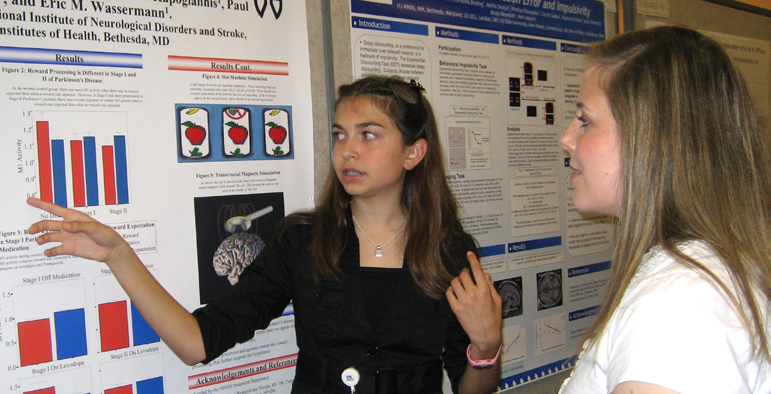Like many of the college students who come to NIH to conduct research each summer, Kelsey Curd Ladt has an exceptional curriculum vitae. She was a valedictorian
in high school and maintains
a near-perfect
GPA as a senior at the University
of Kentucky
in Lexington,
where she is majoring in biology.
She also has a penchant for colorful accessories,
like a neon pink computer keyboard and blue-and-green braces—but none of that is so exceptional considering that she’s 13.
Ladt came to NIH to work with Dr. Eric Wassermann, an investigator at NINDS who studies
systems of reward and emotion in the human brain. From May to early August, she helped run a study testing whether a technique called transcranial
magnetic stimulation (TMS) can be used to probe the brain’s reward system.
“It’s been great seeing what the full-time job of a researcher is,” Ladt says. “I’ve learned skills that I’ll have for the rest of my life.”
Ladt was one of about 80 student researchers
at NINDS for the summer, most of whom came here through the NIH Summer Internship
Program in Biomedical Research. The program
accepts students from high school through graduate school and gives them a chance to work alongside NIH scientists.
“The goal is to get talented students hooked on science and prepare them for a career in laboratory
research or policy,” says Dr. Rita Ward, assistant
director for science administration and Summer
Internship Program director at NINDS.
Ladt was an excellent candidate for the program, Ward says, except that at 13, she was 3 years short of the program’s minimum age requirement. By coordinating with other NIH staff, Ward was able to bring her in as a special volunteer.
“Ever since Kelsey could talk, she said she wanted
to be a doctor, and by the time she was 8, she started showing an interest in medical research,” says Kelsey’s mom, Vickie Curd Ladt.
The Ladts have a home in Paducah, Ky., about a 4½-hour drive from Lexington, where they have a second home. When Kelsey is at school, Vickie and the family’s three Yorkshire terriers live with her. Kelsey’s father Ric works in Paducah during the week and joins them on weekends. The Ladts used the same arrangement this summer while Kelsey was at NIH.
Ladt began showing signs of a prodigious intellect
when she about 2, Vickie recalls. By the time she was in kindergarten, she could read and write and perform third grade math. She rocketed
through elementary school and started splitting
her studies between high school and the local community college when she was 8. In spring 2006, at age 11, she earned both her high school diploma and her associate’s degree, and that fall, she entered the University of Kentucky.
One of the opportunities offered by the university was a year of research with Dr. Joe Springer, a professor
of anatomy and neurobiology. His lab studies the cellular and molecular changes that occur in rat models of spinal cord injury. Ladt’s project focused on changes in the activity of COX-2—a protein involved in inflammation and a target of non-steroidal
anti-inflammatory drugs. Ladt says she hopes to publish the results.
 |
| Kelsey Ladt (l) presents her poster at the 2008 Summer Poster Day, held Aug. 7 in the Natcher Bldg. |
Her research at NIH involved work with human subjects. The ongoing study calls for subjects to play a slot machine type of game while their brain activity is monitored by TMS, which uses a magnetic
pulse to create electrical currents in brain cells. The goal is to determine if TMS can provide a quantitative
measure of reward expectation. If so, TMS could be used to examine why people engage in rewarding behaviors that are balanced by personal harm or sacrifice, such as recreational drug use or charitable giving.
Dr. Dimitrios Kapogiannis, a clinical postdoctoral
fellow in Wassermann’s lab, was Ladt’s direct supervisor. She was involved at every stage of the study, from interviewing potential subjects to helping analyze data, he says. He calls mentoring Ladt “one of the most gratifying experiences” he has had at NINDS.
Ladt and her family and colleagues insist that outside the lab, she is just a normal 13-year-old girl. She’s a fan of the teen pop band the Jonas Brothers and of the teen fiction phenom Twilight, a series of novels about young vampires by author Stephenie Meyer.
Inside the lab, Ladt’s age has not been an issue. She received an Exceptional Summer Student Award for her work at NINDS and Wassermann says that while he had concerns about Ladt’s maturity before he met her, those concerns quickly dissolved.
“I don’t forget for a moment that she’s 13, but I can speak to her as an intellectual equal and that’s a lot of fun,” Wassermann says.
In August, Ladt started her final year at UK. She has already committed to a “postbac” position in Wassermann’s lab after graduation. After that, she plans to enroll in an M.D.-Ph.D. program. “I’m not focused on my age. I’m just focusing on what I want to do,” she says.
Ladt was featured Sept. 23 on the Today show. To view her segment visit http://today.msnbc.msn.com/id/26184891/vp/26851168#26851168.
